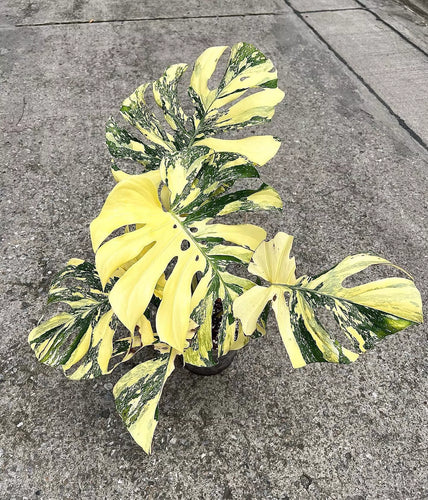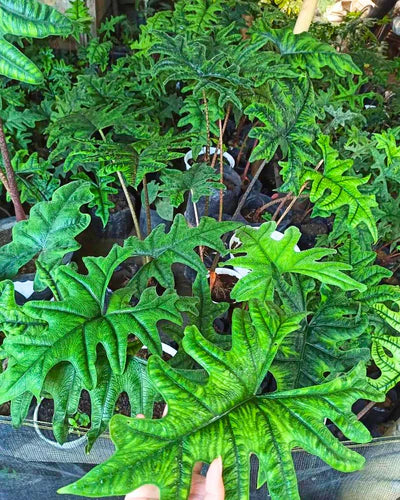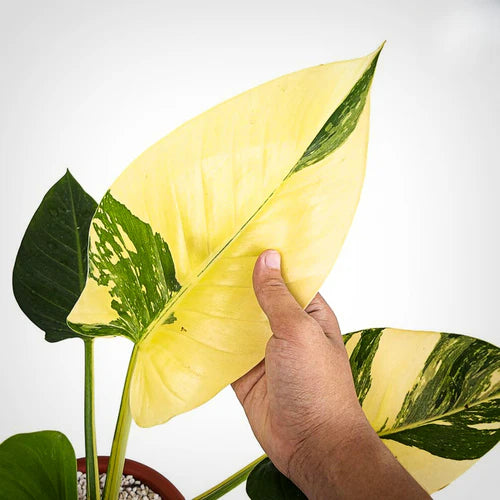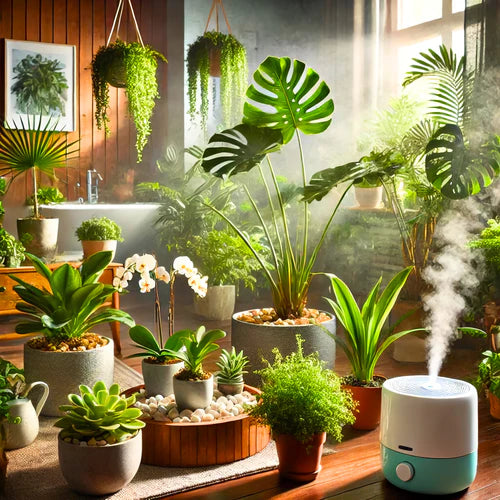Philodendron Melanochrysum Care
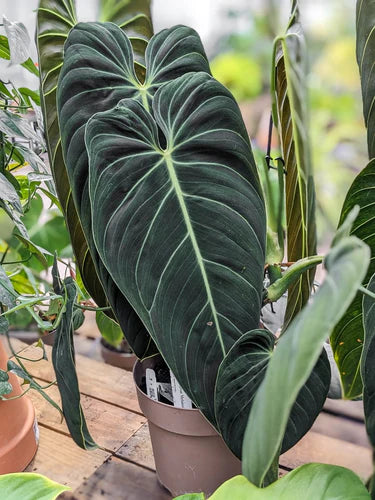
How To Care For Your Philodendron Melanochrysum:
Introduction
The Philodendron Melanochrysum, commonly known as the Black Gold Philodendron, is a lush tropical plant that has taken the houseplant community by storm. With its velvety dark green leaves and golden-yellow veins, it's a stunner you'll want to add to your indoor jungle. But how do you keep this exotic plant happy? In this comprehensive guide, we'll dive deep into all aspects of caring for your Philodendron Melanochrysum, from light requirements to dealing with pests.
Table of Contents
-
Introduction
- Why Choose Philodendron Melanochrysum?
- Quick Facts
-
Getting Started
- Plant Selection
- Placement
- Potting and Soil
-
Essential Care Requirements
- Lighting Needs
- Watering
- Humidity
-
Advanced Care Techniques
- Fertilization
- Repotting
- Pruning and Training
-
Pest and Disease Management
- Common Pests
- Disease
- Prevention and Treatment
-
Pro Tips for Thriving Plants
- Temperature and Climate
- Special Nutrients and Additives
-
Hydroponic Growth
- Benefits
- Steps
-
FAQs and Final Thoughts
- Frequently Asked Questions
- Must-Have Tools
- Final Thoughts

The Velvety Philodendron Melanochrysum
Why Choose This Plant?
Native to the rainforests of Colombia, this Philodendron variant is an eye-catching centerpiece. Whether you are an experienced gardener or a newbie, the plant offers a range of benefits, from air purification to aesthetic appeal. If you want to get your hands on one for cheap, check out this Philodendron Melanochrysum starter plant.
Essential Growing Conditions
Light Requirements
Just like many tropical plants, the Philodendron Melanochrysum prefers indirect sunlight. Too much direct light may burn its leaves, while too little light could affect its growth and coloration. Place it near a north or east-facing window for optimal growth. If you're unsure, a light meter can come in handy to measure the light conditions in your room.
Temperature and Humidity
Ideal temperature ranges between 65°F and 80°F. The Philodendron Melanochrysum thrives in high humidity, so consider using a humidifier especially during the dry winter months.
Nourishing Your Philodendron Melanochrysum
Soil Preferences
Choose a well-draining soil that mimics the tree's natural tropical habitat. A mix of aroid mix and perlite is a good choice to help drainage. If you want to add an extra nutrient boost, mix in some worm castings or organic compost.
Fertilizing
Being a fast grower, this Philodendron tree requires frequent fertilization during its growing season. Use a slow-release fertilizer during spring and summer for best results.
Watering Your Plant
When and How Much to Water
Overwatering can lead to root rot, so it's essential to keep the soil moist but not wet. A moisture meter can help you determine when it's time to water your Philodendron Melanochrysum plant.
Drying Periods
Allow the top inch of the soil to dry out before watering again. In winter, you can cut back on the frequency to avoid overwatering.
Ensuring Healthy Growth
Climbing Support
As a natural climber, the Philodendron Melanochrysum enjoys having a clear moss pole for support as it grows upwards.
Light Enhancement
If you're growing your plant indoors, grow lights can supplement natural light, especially during winter months when sunlight is limited.
Dealing with Pests and Diseases
Common Pests
Keep an eye out for pests like mealybugs and spider mites. Neem oil or insecticidal soap can be effective treatments. For a preventive measure, try Bonide Systemic Houseplant Insect Control.
Advanced Care Tips for Philodendron Melanochrysum
Thank you for staying tuned! After covering the essentials in the first section, let's dig deeper into advanced care tips to make your Philodendron Melanochrysum flourish. We'll explore propagation, potting, and additional care techniques that you can use to ensure your plant thrives.
The Art of Propagation
Cuttings Technique
If you're looking to propagate your Philodendron Melanochrysum tree, stem cuttings are the most straightforward method. Ensure that you use sterilized scissors and cut just below a node, leaving at least two leaves on the cutting.
Rooting Medium
After cutting, you can place the stem in water or directly into a soil mix. For better moisture retention and aeration, consider using sphagnum moss as your rooting medium.
Rooting Hormones
Although optional, rooting hormones can speed up the rooting process. Dip the cut end of your cutting into a rooting hormone before planting.
Repotting Your Plant
When to Repot
You will generally need to repot your Philodendron Melanochrysum plant every two years or when it outgrows its pot. Signs that it's time include slow growth and water pooling on the soil surface.
Potting Mix
When repotting, it's an excellent opportunity to assess your soil conditions. You may use the same mix of aroid mix and perlite, or introduce Leca for better drainage.
Pot Selection
Always use a pot with drainage holes. You can use either ceramic or plastic pots, but remember that ceramic pots are porous and may dry out faster.
Special Additions for Better Growth
Hydroponic Systems
If you're an enthusiast looking to venture beyond traditional soil planting, you could consider a hydroponic system for your Philodendron Melanochrysum tree. Hydroponics allows for better control over nutrients and pH, although it's a bit more technical.
Automated Systems
For the tech-savvy, there are automated watering and light systems that can simplify care. Some of these systems can be connected to your phone, enabling you to control them remotely.
Seasonal Care
Winter Care
During winter, reduce watering and skip fertilizers as the plant goes into a semi-dormant state. To counter the reduced daylight hours, you might want to use grow lights.
Summer Care
In summer, your Philodendron Melanochrysum will be in its active growth phase. Increase watering and feed it with slow-release fertilizer.
Trouble Signs and Solutions
Yellow Leaves
If your Philodendron Melanochrysum tree has yellow leaves, it might be a sign of overwatering. Check the moisture level and adjust your watering schedule accordingly.
Pests
Apart from neem oil and insecticidal soap, you can also use Bonide Systemic Houseplant Insect Control for more persistent pest problems.
Drooping Leaves
Drooping leaves could be due to inconsistent watering. Make sure you are neither overwatering nor underwatering. A moisture meter can be particularly useful here.
Fun DIY Ideas for Your Philodendron Melanochrysum
Make Your Moss Pole
Though you can purchase a clear moss pole, making one at home can be a fun DIY project. All you need are some wooden stakes and sphagnum moss.
Decorative Pots
Personalize your Philodendron Melanochrysum plant by choosing decorative pots that match your interior décor.
FAQs and Final Thoughts on Philodendron Melanochrysum Care
You've made it to the final section! By now, you should have a comprehensive understanding of Philodendron Melanochrysum care, from the basics to advanced techniques. Let's round off with some frequently asked questions and final thoughts to make your plant care journey complete.
Frequently Asked Questions - Philodendron Melanochrysum:
Is Philodendron Melanochrysum rare?
While not extremely rare, Philodendron Melanochrysum is less common in regular plant stores. However, specialized sellers do offer them, and you can find a beautiful Philodendron Melanochrysum starter plant here.
Is Philodendron Melanochrysum hard to care for?
Not particularly. If you follow the care guidelines we've outlined, your plant should flourish. A moisture meter and a light meter can help you monitor its needs more precisely.
Does Philodendron Melanochrysum need a moss pole?
Yes, it’s a climbing variety that will appreciate the support of a moss pole for optimal growth.
What is the difference between Philodendron Micans and Melanochrysum?
While both are climbing Philodendrons, Micans has smaller, velvety leaves with more of a purplish hue, while Melanochrysum has larger, dark green leaves.
Is Philodendron Melanochrysum a climber or crawler?
It’s primarily a climbing plant, which means a moss pole or some form of support will help it grow optimally.
Must-Have Tools for Philodendron Melanochrysum Care
Nutrient Additions
- Worm castings
- Organic compost
Pest Control
- Neem oil
- Insecticidal Soap
Monitoring Tools
Final Thoughts
Caring for a Philodendron Melanochrysum houseplant, is a fulfilling endeavor as you watch it grow. With their lush, velvety leaves, they can turn any space into a tropical haven. Even if you are a beginner, by following these guidelines, you should have no trouble growing a healthy and beautiful Melanochrysum.
Remember, the more you understand your plant, the easier it becomes to care for it. The Melanochrysum is forgiving and will often show you signs when something is off. From yellowing leaves to drooping, you'll be able to make adjustments as needed, ensuring that your plant thrives for years to come.
Happy Planting!
Have comments or questions? Comment below!


